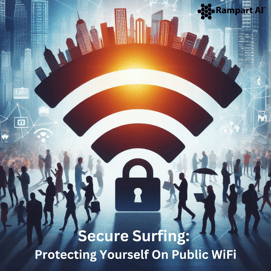In case you need one, here is an official welcome into the holiday season.
Secure Surfing: Protecting Yourself on Public WiFi
 Public WiFi networks have become a major part of our daily lives. Whether you're at a coffee shop, airport, hotel, or shopping mall, chances are you've joined public WiFi to stay connected or catch up on work. While convenient, public WiFi networks pose serious security risks. In this blog, we'll explore the security challenges of public WiFi and provide tips on how to make your connection more secure.
Public WiFi networks have become a major part of our daily lives. Whether you're at a coffee shop, airport, hotel, or shopping mall, chances are you've joined public WiFi to stay connected or catch up on work. While convenient, public WiFi networks pose serious security risks. In this blog, we'll explore the security challenges of public WiFi and provide tips on how to make your connection more secure.
The Risks of Public WiFi
Public WiFi networks are often open and unencrypted, making them vulnerable to various security threats. Here are some of the common risks associated with using public WiFi:
- Eavesdropping: Hackers can intercept your data packets, including login credentials and personal information, as they travel over the unsecured network.
- Man-in-the-middle attacks: Attackers can position themselves between your device and the network, intercepting and altering your communications.
- Malware distribution: Public WiFi networks can serve as a platform for spreading malware. If your device is not adequately protected, it can become infected.
- Fake hotspots: Cybercriminals can create rogue WiFi networks with names similar to legitimate ones, tricking users into connecting to them and compromising their data.
- Untrusted network administrators: In some cases, network administrators with malicious intent may exploit their privileged position to access your data.
How to Secure Your Public WiFi Connection
Protecting yourself on public WiFi requires vigilance and a few best practices. Here are some steps you can take to enhance your security:
- Use a Virtual Private Network (VPN): A VPN encrypts your internet traffic, making it much harder for attackers to intercept your data. Use a reputable VPN service to establish a secure connection to the internet.
- Choose Known Networks: When possible, connect to trusted and well-known public WiFi networks. Verify the network name with staff or signage to avoid falling victim to fake hotspots.
- Turn Off Sharing: Disable file and printer sharing on your device when connected to public WiFi. This prevents unauthorized access to your files.
- Enable a Firewall: Make sure your device's firewall is active to block unauthorized incoming connections.
- Use HTTPS: Ensure that websites you visit use HTTPS encryption. Many websites now default to HTTPS, which secures your connection to the site.
- Keep Software Updated: Regularly update your operating system, applications, and antivirus software to patch known security vulnerabilities.
- Forget the Network After Use: Disconnect from public WiFi networks and set your device to "forget" the network after you're done to prevent auto-reconnection.
- Use Two-Factor Authentication (2FA): Enable 2FA for your accounts. Even if someone obtains your login credentials, 2FA provides an extra layer of security.
- Avoid Sensitive Transactions: Refrain from conducting sensitive transactions like online banking or shopping while on public WiFi. Wait until you have a more secure connection.
- Monitor Your Devices: Keep an eye on your devices for suspicious activity and be cautious of unsolicited requests for sensitive information.
Public WiFi is a convenience, but it comes with significant security risks. Implementing the tips mentioned above can go a long way in protecting your data and online activities while using public WiFi networks. By staying vigilant and taking steps to secure your connection, you can enjoy the benefits of public WiFi without compromising your personal information or sensitive data.




